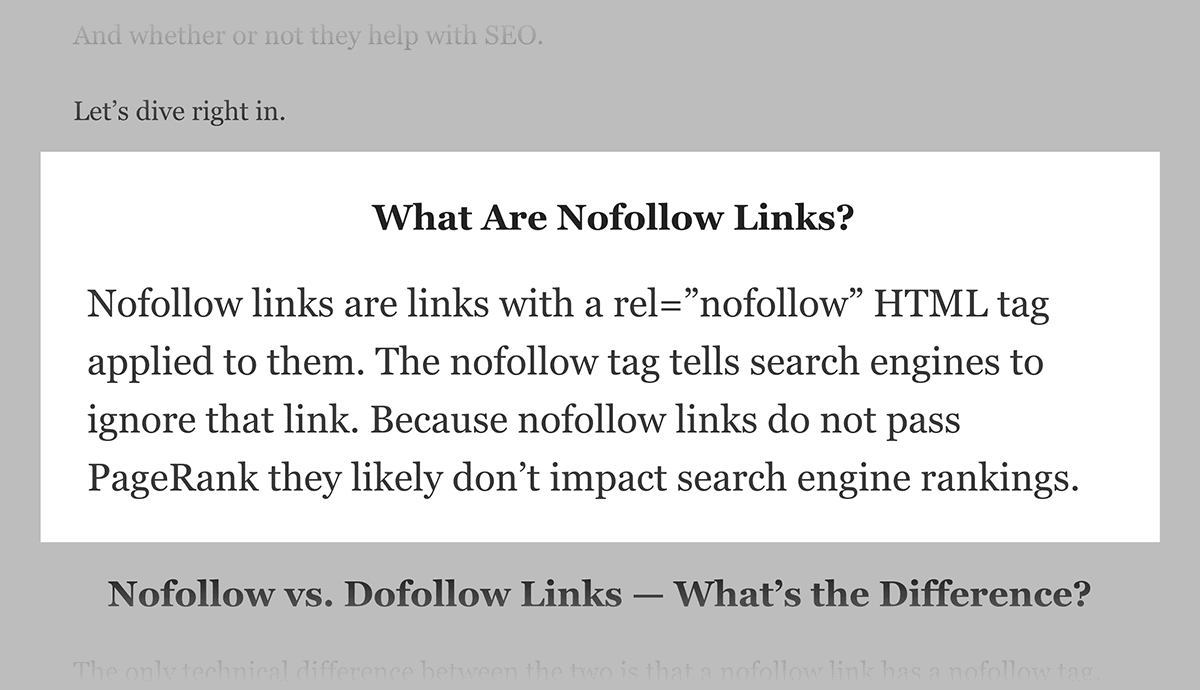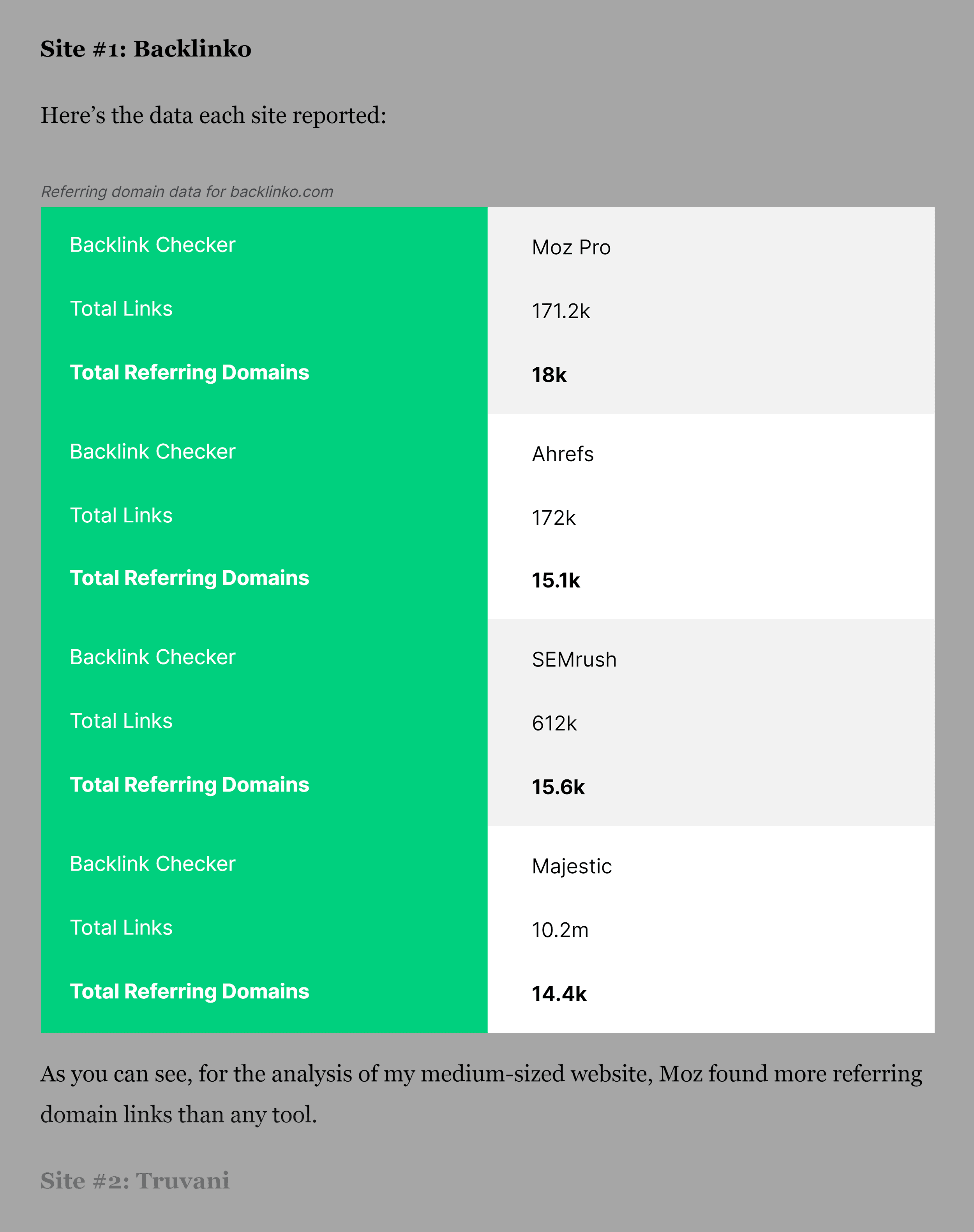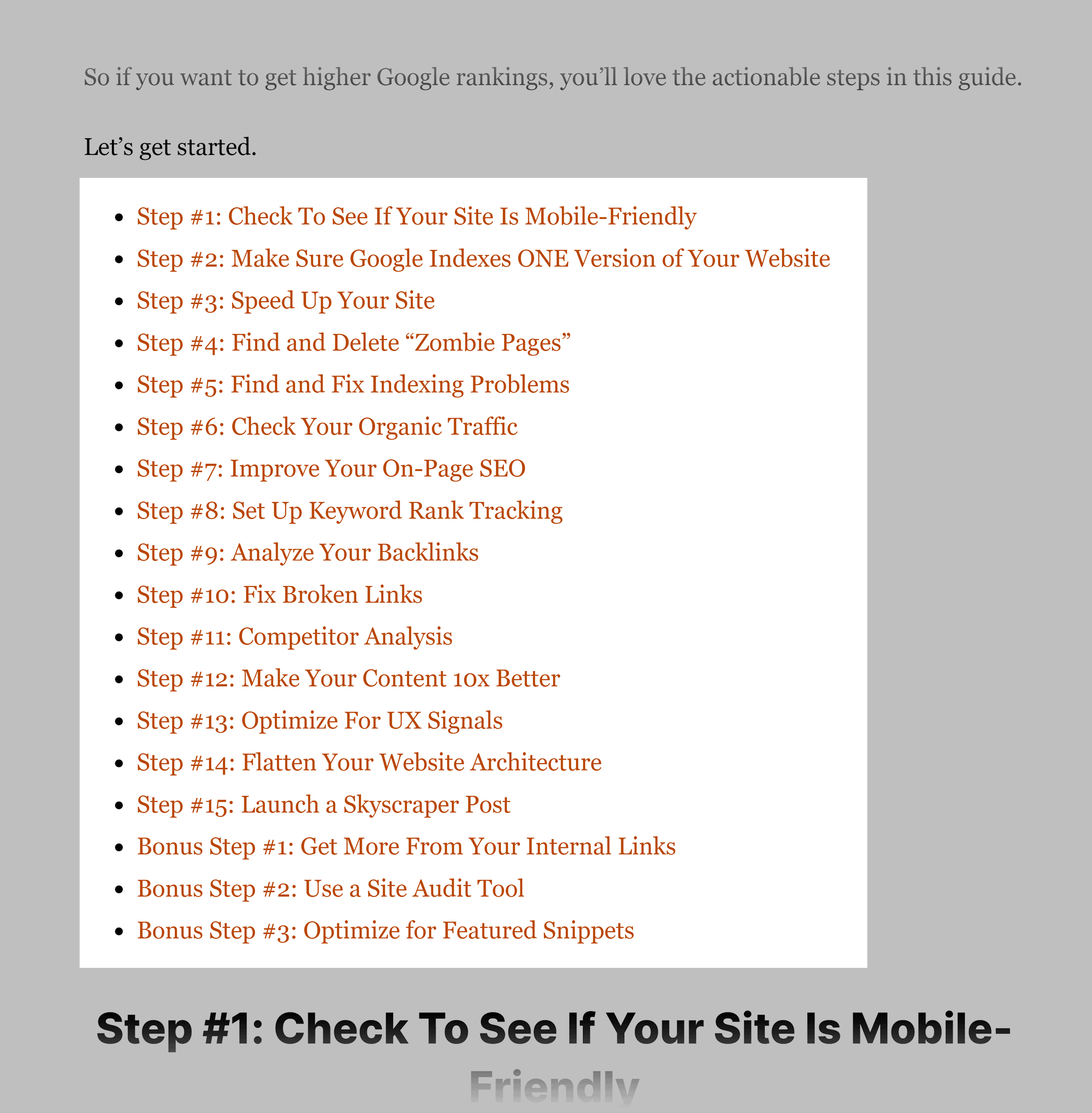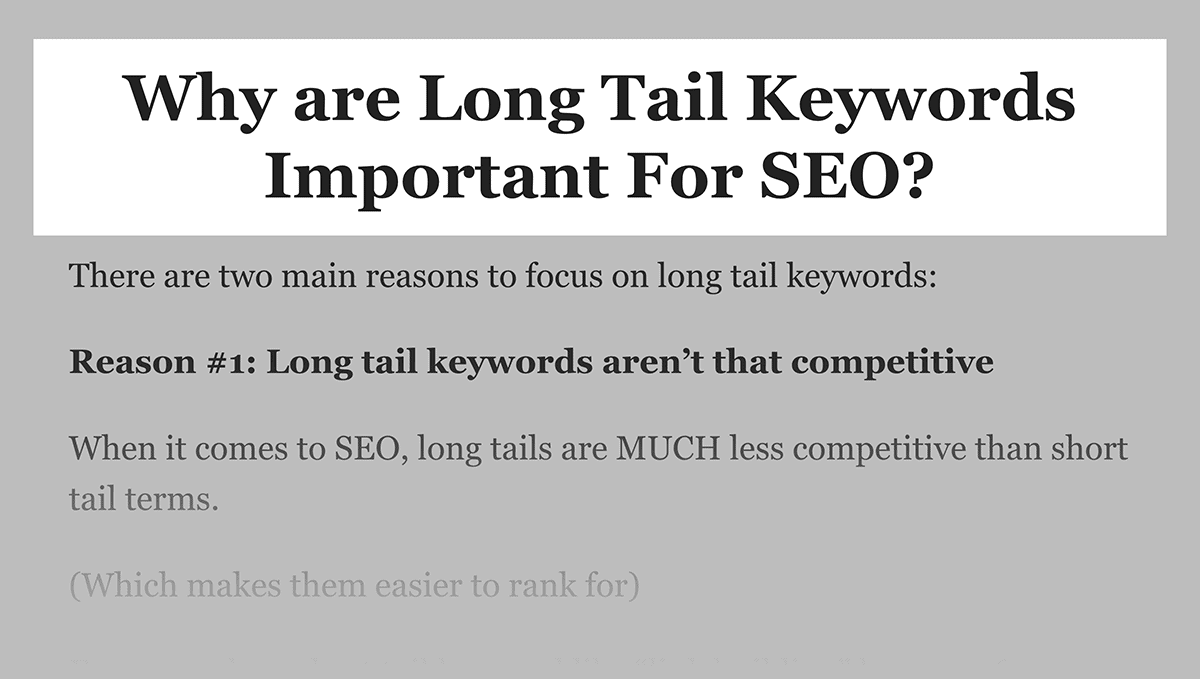Featured Snippets
What Are Featured Snippets?
Featured Snippets are special search result boxes that appear at the top of Google’s search results (in position 0), displaying automatically extracted content from web pages. These highlighted excerpts aim to provide quick, relevant answers to user queries. They come in several formats, including definitions, tables, steps, and lists. For websites, gaining a featured snippet position can significantly increase visibility and organic traffic.

Why Are Featured Snippets Important for SEO?
Featured Snippets impact SEO in two ways.
First, Featured Snippets are an opportunity to get more clicks from the organic search results… without higher Google rankings.
In fact, many SEO experts refer to the Featured Snippet box as “Position #0” because it appears above the traditional #1 spot.

According to Search Engine Land, a Featured Snippet gets approximately 8% of all clicks.

So if you’re able to get your content in the Featured Snippet, you can give your organic click-through-rate a serious boost.
For example, we were able to rank in the Featured Snippet for this keyword:

According to the Google Search Console, our organic CTR for that page is 10.7%.

Second, Featured Snippets increase the number of “no-click searches”. In other words, when a Google user doesn’t click on any of the search results.
That’s because the Featured Snippet often gives someone the direct answer they’re looking for.

So, before you decide on a specific keyword, it’s important to check the SERP to see whether the results have a Featured Snippet. If so, according to an industry study by Ahrefs, you’ll get fewer clicks compared to SERPs without a Featured Snippet.
That’s not to say you should automatically toss out a keyword if there’s a Featured Snippet. After all, Semrush reports that 4.77% of all queries have a Featured Snippet.

This means that it’s going to be tough to completely avoid keywords with a Featured Snippet.
It’s more that, along with competition and monthly search volume, Featured Snippets should factor into your process for choosing keywords.
Types of Featured Snippets
There are 4 main types of Featured Snippets that appear most often in Google’s search results.
1. The Definition Box: This is a snippet of text designed to give searchers a direct, concise definition or description.
For example, when you search for “outreach email”, there’s a definition box at the top of the results.

Google commonly uses these paragraph snippets to provide a quick answer to “what is” queries. Here’s an example:

As you can see, the definitions that Google tends to use are short and sweet. In fact, Semrush found that the average definition Featured Snippet is between 40-60 words long.

2. The Table Snippet: This is where Google pulls data from a page and displays it as a table.
Here’s an example:

3. The Ordered Snippet List: This is a list of items presented in a specific order. Google tends to use Ordered Lists for queries that need a set of steps.

They also use ordered lists for lists that rank things in a specific order, like this.

4. The Unordered List: This is Google’s way of presenting a bulleted list of items that don’t need to be in any particular order.
For example, our list of rank tracking tools isn’t in order of best to worst. It’s just a list (but we do feature a table with, in our opinion, the best tools).

Which is why Google just presents each tool that we list as a simple list, without any information that ranks them one way or the other.

How to Optimize For Featured Snippets
Find SERPs With a Featured Snippet
Your first step is to look for a search results page that already has a Featured Snippet.
(In other words, Featured Snippet opportunities.)
That way, you KNOW that Google wants to show a Featured Snippet for that term. In fact, they already do!
Also, you can see what type of Featured Snippet Google wants to show for that term (The Definition, Unordered List, etc.). Which makes optimizing your page for that specific type of Featured Snippet super simple.
There are two ways to look for SERPs that have a Featured Snippet.
First, you can search for a bunch of keywords one-by-one. So if you have a list of potential keywords to target, you can search for each one and jot down whether or not the results for that term have a Featured Snippet.

Second, you can use a tool like Semrush and Ahrefs to zero-in on keywords with a Featured Snippet.
For example, when you run an Organic Keywords report on Backlinko using Semrush, you can filter out any keywords that don’t have a Featured Snippet already.

Optimize For That Specific Featured Snippet
Next, it’s time to optimize the content on your page so Google chooses to use your content in the Featured Snippet.
Here’s how to optimize your content for the 4 most popular types of Featured Snippets.
The Definition: You need to provide Google a short (40-60 word) snippet of text that they can directly use in the Featured Snippet. It also helps if you have “What is X” directly above your definition.
Here’s an example of this type of setup on one of our pages.

And because we’re giving Google a word-for-word definition they can use, we got in the Featured Snippet spot within a few months.

HubSpot takes this a step further. They actually design little boxes in their content that look just like a Featured Snippet.

I don’t think you need to go this far. But it does go to show that formatting is KEY for getting your content in the Featured Snippet. Specifically, the closer your content looks like a Featured Snippet, the more likely it is that Google will use it.
The only other thing to keep in mind is that you want your definition to be objective. In other words: don’t include an opinion on the topic either way.
Remember: Google doesn’t want opinions showing up as definitions. So, even if you have a strong feeling about the topic, do your best to write the definition without any emotion. In fact, you should write the definition like a dictionary entry.
For example, you can see that our definition for “nofollow links” sounds like it was pulled directly from Webster’s Dictionary.
The Table: From my own analysis I’ve found that Google tends to get content for Table Featured Snippets from tables.
In other words: they’re not collecting data from various parts of your page and presenting it in table form. Instead, they’re essentially scraping tables that already exist.
For example, check out this table Featured Snippet.

Well, when you look at the source of that content, you can see that it’s literally the exact same table.

As another example, at one point, we compared the top 4 backlink checker tools.

And one of the ways that we optimized for the Featured Snippet was to present a lot of the data in the form of tables.

How you code these tables depends on how your site is set up (and whether or not you use WordPress). But in general, as long as your HTML uses the <tr> tag to present the data in a table, Google should have an easy time “reading” your table.
The Ordered List: The key here is to lay out your page so that the specific steps or lists of items are presented in a way that Google can easily understand.
Specifically, you want to wrap every item or step in H2 or H3 text. And present each item as a subheader.

To make the order of your items or steps crystal clear to Google, you can even include text like “Step #1” or “1.” in each subheading. Here’s an example:

The most important thing to keep in mind is that consistency is key. So if you present step #1 as “Step #1: Do X”, don’t make your second step: “Step 2: Do Y”.
Instead, present your steps like this:
Step #1, Step #2, Step #3…
Or like this:
1., 2., 3…
I personally prefer “Step #1” over “1.” because it’s easier for users to follow along. But Google can understand both.
For example, this post lays out a 9-step SEO strategy.

Each step in the process uses the exact same format (“Step #1”, “Step #2”, etc.).

We also wrap each step in an H2 tag.
Optimize Your Page Around Several Different Long Tail Terms
Ahrefs discovered that the vast majority of Featured Snippets show up when people search for long-tail keywords.

(Long tail keywords=terms that people use in search engines that are super long and super specific.)
Queries that people use for voice search are perfect examples of this type of search.
Here’s an example of a traditional search.

And here’s a conversational, long tail version of that same search query.

The takeaway here is that you don’t just want to optimize your content for Featured Snippet keywords that lots of people search for (like “what is SEO”).
You ALSO want to optimize for Featured Snippets that show up when people search for variations and long tail versions of those terms.
For example, you can see that we added sections to this page that are designed to rank for a bunch of different long tail Featured Snippets.

It’s almost like a mini FAQ page.
So: how do you know what long tail keywords to target?
I recommend checking out the “People Also Ask boxes” in the SERPs.

These are related questions that Google considers closely related to the keyword you just searched for.
For example, one keyword that we’re in the Featured Snippet spot for is “search intent”.

And that ranking is a direct result of optimizing our content for the definition snippet.

That said: there are lots of long tail queries that we could answer on that same page. Queries that Google shows us right in the search results.

Speaking of scaling…
Scale Your Featured Snippet SEO Efforts
If your page (and site) has authority, you can rank your single page for dozens of Featured Snippets.
The key to scaling this up is to add lots of definitions, ordered lists and other formats that Google loves to put into Featured Snippets on your page.
For example, you can see that HubSpot has one “main” definition at the top of most of their pages.

But they also toss in several questions and answers on a single page.

Improve Your Google Rankings
It’s one thing to optimize your content for Featured Snippets. But the truth is: if your page doesn’t already rank on Google’s first page, your chance of getting in a Featured Snippet is practically zero.
In fact, according to the Ahrefs study I mentioned earlier, 99% of all Featured Snippets are from pages that already ranked on page 1.

This makes sense if you think about it: the first page is a list of Google’s best, most trusted content about that topic. So they’re not about to pull info from a site on page 11… even if it’s formatted perfectly.
So besides formatting your content the right way, you also need to rank on page 1 to have a real shot of getting in the Featured Snippet box.
For example, this page from our site ranks “#0” as a Featured Snippet.

And we only got featured there after we cracked Google’s first page for that term.
Learn More
How to Optimize for Google’s Featured Snippet Box: This video shows you how to increase the odds that you’ll rank in Google’s Featured Snippet section.
How To Be Featured On Top Of Google: An upbeat, in-depth tutorial on Google Featured Snippet optimization.
